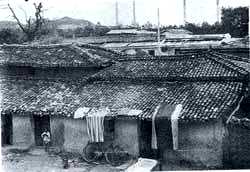The other side of migration
 IN INDIA'S Industrial Cities, Nigel Crook seeks to correct the growing imbalance in the reigning debate over the ills of technology-wrought urbanisation. In a given situation, where most works of authority tend to focus on the problem of labour supply and the negative role of excess migration, Crook's short but well-researched book dwells on the positive aspects of migration.
IN INDIA'S Industrial Cities, Nigel Crook seeks to correct the growing imbalance in the reigning debate over the ills of technology-wrought urbanisation. In a given situation, where most works of authority tend to focus on the problem of labour supply and the negative role of excess migration, Crook's short but well-researched book dwells on the positive aspects of migration.
The urbanisation debate introduces us to a familiar but striking kaleidoscope of urban images -- hutments close to railway lines, dilapidated dwellings, colourfully clad women crouching to wash clothes in pools of muddy water, buffaloes wallowing in knee-deep water and hogs scampering around in rubbish. There is squalor and stench, but there is also liveliness and livelihood.
It is this factor that is fundamental to Crook's argument. Whereas other studies stress the commercial functions of cities, this book emphasises the industrial nature of urbanisation. Crook acknowledges the problems of industrialisation, but he says these problems need to be addressed at a different level, and this redressal should not be allowed to stifle the processes of industrialisation.
The sympathetic reader works his way into a station beyond the orange-tiled roofs, where a small boy climbs aboard a train. Eyes misty and nose running, he sweeps the carriage floor and asks for coins. A pitiable plight no doubt, but the grim reality is that if he had stayed on in his native hills, he'd probably have died of some disease.
One realises industrial cities are India's major resources -- a creation of the processes of industrialisation, which is itself fundamental to economic growth. The demand for industrial labour, according to Crook, has been the prime reason for the formation of cities and a significant factor in the sustained spread of urbanisation itself. In fact, the relationship between industrialisation and the formation of cities starts with the industrial demand for labour. In this sense, the chapter on recruitment and migration of the industrial labour force is the cornerstone of the book and the distillation of its central theme.
Labour is differentiated by characteristics such as age and sex and the needs of the employer, and the effects of demographic transition reflects this fact. According to Crook, however, further distinctions can be made on the basis of ethnic, linguistic and caste compositions of a city and all these can be traced to recruitment policy. The book raises some intriguing questions on the historical role of death rates in the growth of cities.
At the end of the book, Crook hits upon a rather interesting topic -- the costs involved in fulfilling the requirements of an industrialising economy. He dwells on the problems of meeting these costs, which are both efficient and equitable.
Related Content
- Future smart food: rediscovering hidden treasures of neglected and underutilized species for zero hunger in Asia
- Bangladesh State of Environment Report: The Monthly Overview, April 2014
- A long and winding path (Cover story)
- Murder mystery in Bihar
- Wild elephants migrating to Bangladesh
- Battle zone: Humans vs elephants
